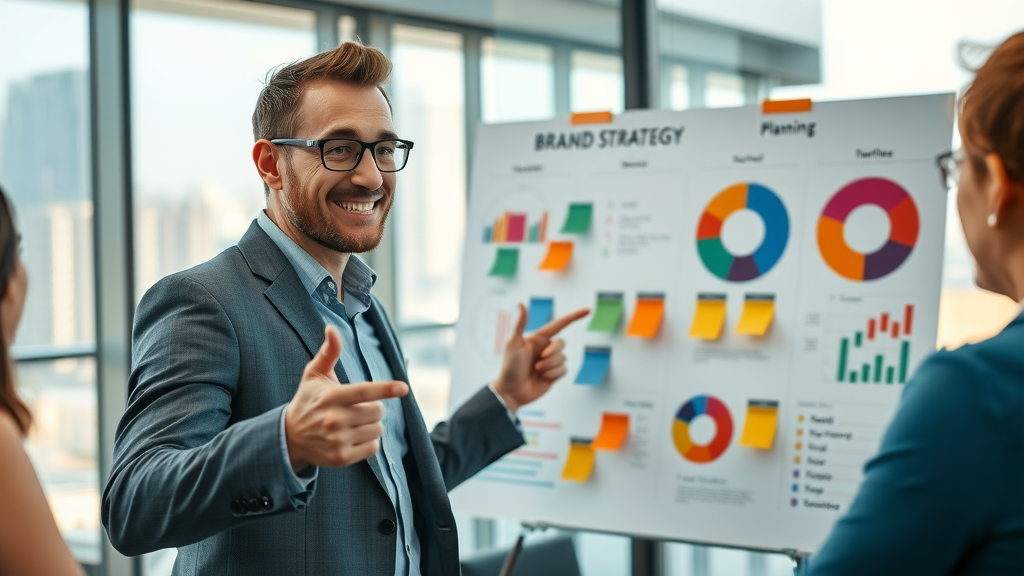Did you know a strong brand identity can boost customer loyalty by up to 33% ? In today’s fast-paced market, your brand identity isn’t just a logo—it’s the magic ingredient that instantly captivates customers, sets you apart, and fosters unwavering trust. Read on to uncover the expert-backed secrets to transforming your brand into a show-stopping force, no matter your industry or business size.

Why Brand Identity Matters More Than Ever in 2024
In the digital-first landscape of 2024, brand identity is the pulse of every successful business. The competition is fiercer than ever, and customers are bombarded with countless options. To rise above the noise, your brand must be instantly recognizable and emotionally resonant. From your logo design to your brand voice, every touchpoint sends a message about who you are and why you matter.
A cohesive and modern brand identity builds not only recognition but trust. Consumers want to support brands that reflect their own values, showcase original brand elements, and tell a memorable brand story. A recent study shows that companies with a well-defined, strong brand identity enjoy higher customer retention, organic referrals, and even resilience in the face of market disruptions. Simply put, a transformative brand identity isn’t optional—it’s essential for growth.
A Surprising Fact About Brand Identity and Consumer Trust
"A strong brand identity can increase customer loyalty by up to 33%—making your brand unforgettable in a crowded market."

What You'll Gain from Mastering Brand Identity
Mastering brand identity arms your business with powerful strategic advantages. When you understand and apply modern branding principles, you’re able to connect authentically with your audience, outshine competitors, and lay the groundwork for consistent, long-term growth. Whether you’re creating a brand style guide or developing a new brand persona, these skills are indispensable.
- Understand the core elements and pillars of a strong brand identity
- Explore step-by-step strategies to develop a memorable visual identity
- Learn how to craft a compelling brand story and impactful brand guidelines
- Discover real-world examples of successful brand identity
- Gain practical tactics for aligning social media and digital touchpoints
Defining Brand Identity: Foundation of a Strong Brand

Before you can build or transform a brand, you must first grasp what brand identity truly means. At its core, brand identity encompasses everything your company represents—visuals, voice, values, and the promises you make to your customers. Unlike simple branding or a logo, brand identity is the full spectrum of how your business is perceived and experienced. It’s how you differentiate your product or service, and ultimately, it’s the reason customers remember and choose you.
A strong brand identity includes more than nice graphics. It relies on comprehensive consistency—from your brand color schemes and typography to your messaging and customer interactions. The best brands ensure every detail tells a unified, compelling brand story. By intentionally creating a brand identity, you control the narrative and inspire brand loyalty across every touchpoint.
What Is Meant by Brand Identity?
Brand identity refers to the collection of brand elements—logo, color palette, typography, messaging, and personality—that together define how your brand is perceived. It represents your mission, values, and the emotional promise delivered to your target audience . A strong brand identity helps your business stand out in competitive markets, communicate effectively, and build emotional connections that drive loyalty. Unlike brand image, which is how the audience perceives you, brand identity is the message you actively shape and present to the world.
The Distinction Between Brand Identity and Brand Image
It’s easy to confuse brand identity with brand image . While the two are closely linked, they serve different roles in branding success. Brand identity is what you consciously create: your values, visuals, messaging, and tone. In contrast, brand image is the perception and beliefs that exist in the minds of your customers—the result of their experiences, stories they’ve heard, and emotions you evoke. Managing both is crucial for maintaining a consistent brand that inspires trust and advocacy.
| Brand Identity | Brand Image |
|---|---|
| Visuals, messaging, personality, values crafted by the business | Perception and feelings held by the target audience |
| Controlled and designed by internal teams | Formed externally by customer experiences, reviews, and word of mouth |
| Includes logo, color palette, tone, guidelines, and stories | Reflects emotional reactions, trust, and reputation |
| Proactive process—actively communicated | Reactive—shaped over time through interactions |
The Five Pillars of Brand Identity: Building Blocks for Success
Every strong brand identity rests upon five fundamental pillars. These cornerstones work together to create a unified, memorable, and impactful presence for your business. Understanding and mastering each pillar will enable you to create a brand that truly resonates, regardless of your industry or audience size.
When you intentionally develop these pillars—brand purpose, positioning, visual identity, personality, and voice—you transform your organization from a simple provider of products or services into a beloved partner for your customers. Let's break down what these pillars entail and why they matter.
What Are the 5 Pillars of Brand Identity?
- Brand Purpose: The reason your business exists beyond making a profit.
- Brand Positioning: How your brand is uniquely placed in the marketplace.
- Visual Identity: The visual elements—logo, colors, fonts—that make your brand instantly recognizable.
- Brand Personality: The set of human traits and attributes reflected in your communications.
- Brand Voice: The unique style, tone, and language you use to connect with your audience.
| Pillar | Description | Example |
|---|---|---|
| Brand Purpose | Your company’s mission and reason for being | Patagonia’s commitment to environmental activism |
| Brand Positioning | Market niche and what sets you apart | Tesla’s focus on innovative, high-performance electric vehicles |
| Visual Identity | Logos, color palette, typography, design elements | Apple’s minimalist visuals and monochrome branding |
| Brand Personality | Human characteristics your brand embodies | M&Ms’ playful, humorous advertising approach |
| Brand Voice | Distinct tone and communication style | Dove’s empowering, authentic tone in campaigns |
Creating a Strong Brand Identity: Strategy and Steps

- Define your target audience with precision
- Develop a compelling brand story
- Craft a unique visual identity and color palette
- Establish clear brand guidelines
- Ensure messaging consistency across all channels
To create a brand identity that stands the test of time, begin by tightly defining your target audience . Understanding who you serve fuels every other branding decision—from the words you use to the visuals that represent your mission. Next, develop a brand story that deeply connects, sharing your purpose and forging emotional bonds.
The next step: craft a visual identity and color palette that communicate your essence at a glance. Solidify your vision with detailed brand guidelines to guarantee every team member and channel embodies your unique style. The goal is simple: ensure every touchpoint, from your website to your social media, consistently reinvents your brand identity —capturing hearts and driving growth.
Developing a Brand Strategy for a Memorable Brand Identity
A well-crafted brand strategy forms the backbone of a memorable brand identity . Your strategy should seamlessly link every element of your brand with your long-term business goals. This means assessing your market landscape, refining your positioning, and ensuring that every aspect of your brand—from your visuals to your voice—tells a cohesive, captivating story.
By aligning your brand strategy and brand identity, you make it easy for your customers to understand—and love—what you stand for. When all the elements work together in harmony, you’ll foster increased brand loyalty, higher conversion rates, and create a competitive advantage your rivals can’t match. Strategic branding is a growth supercharger.
Aligning Brand Strategy with Brand Identity
Powerful branding is intentional, not accidental. Aligning brand strategy with brand identity ensures every channel, campaign, and customer experience supports your big-picture vision. This means linking your core values and mission to the visual identity , brand voice , and the messages you share. Use a brand persona —a fictionalized representation of your ideal customer—to keep your audience at the center of every strategic decision.
Regularly revisit your brand style guide to check whether your marketing, social media, and even customer service align with your identity include values. Adjust your approach as your brand, market, or audience evolves. Purposeful consistency across touchpoints creates a strong brand no competitor can duplicate.
Brand Persona and Brand Story: Building Emotional Connections

Your brand persona is the personification of your business. Give your brand real human personality traits—are you playful or serious, bold or calm, witty or sincere? Knowing your persona helps you connect with customers through authentic, relatable communication. When your audience can see themselves in your brand, true loyalty flourishes.
An irresistible brand story is what transforms customer transactions into lasting relationships. Share your journey, your challenges, and your reasons for existing. The art of storytelling not only humanizes your company but inspires your target audience to champion your mission and reinforce your strong brand identity .
From Logo to Color Palette: Designing Visual Brand Identity
Your visual identity is the face of your brand. Stunning logo design , expertly chosen brand colors , and a distinctive color palette all work together to make your brand instantly memorable. Customers remember images and colors faster than words—so leveraging these tools is essential for making your business stand out.
A professional visual identity doesn’t just attract attention; it communicates your values and promises at a glance. The way you use imagery, illustration, patterns, and even white space can make your brand style pop or flop. Successful brands revisit and refine their visuals regularly, ensuring their brand identity remains fresh but consistent.
The Role of Logo and Visual Design in Brand Identity
Your logo design is often the first impression your audience gets. A well-designed logo reflects your brand personality, mission, and market positioning. Pairing your logo with a signature color scheme and visual motifs helps reinforce recognition and builds brand loyalty—think of how quickly you know a brand by its colors and shapes alone. Consistent visuals throughout your website, packaging, and social media reinforce your strong brand identity .
| Color | Emotion/Perception | Brand Identity Example |
|---|---|---|
| Red | Energy, Passion, Excitement | Coca-Cola |
| Blue | Trust, Reliability, Security | IBM, Facebook |
| Green | Growth, Health, Freshness | Starbucks, Whole Foods |
| Black/White | Luxury, Elegance, Simplicity | Apple, Chanel |
| Yellow | Optimism, Warmth, Creativity | McDonald's, National Geographic |
Creating Consistent Brand Guidelines

A detailed brand guideline is your blueprint for maintaining consistency across all platforms and content. Your style guide should clearly define your logo usage, color palette, typography, imagery, voice, and the do’s and don’ts for representing your brand. When everyone, from designers to social media managers, follows these guidelines, your brand identity stays strong even as your business grows.
Regularly update your brand style guide as your business evolves. Share it with your team and partners, and ensure it’s accessible and easy to understand. The more you reinforce your visual and verbal standards, the easier it is to build instant recognition and trust.
Brand Voice and Tone: Expressing Brand Identity Authentically
An authentic brand voice sets your communication apart in a noisy world. Whether your tone is professional, friendly, witty, or bold, consistency is key. A unified voice shapes the way customers perceive your business and reinforces every element of your brand identity .
Set clear voice and tone guidelines, specifying how your team should communicate in advertisements, customer support, and social media. Your “brand voice” becomes the heartbeat of your visual identity —it’s how your brand sounds in every conversation and campaign.
Defining Brand Voice and Tone Guidelines
Establish your core voice attributes (e.g., energetic, trustworthy, innovative) and align them with your brand personality. Decide how your brand should sound in different scenarios—product launches, crisis communications, or social engagement. Document examples and best practices within your brand guideline so anyone representing your business can quickly adapt.
"A consistent brand voice is the heartbeat of strong brand identity."
Remember, your voice and tone should support and reflect the character and values you want your customers to associate with your brand. The key is authenticity—don’t just sound like everyone else; stand out and make a lasting impression.
Adapting Brand Voice for Social Media
Social media offers opportunities to showcase your brand voice creatively and directly engage your audience. Adapt your tone to each platform while maintaining consistency with your overarching persona. More casual, interactive language may suit Twitter and Instagram, while longer, more informative content fits LinkedIn or blog posts.
Respond to comments, DMs, and feedback in a way that feels personal and true to your brand style. Consistency across channels enhances trust—and your audience will quickly recognize your unique vibe wherever they connect with you.
Crafting a Compelling Brand Story to Elevate Brand Identity
Stories are the most powerful tool for transforming brands into movements. A compelling brand story goes beyond facts and features, tapping into emotions and values. When you share your origins, mission, and challenges authentically, your customers feel invested in your journey—and more likely to become loyal advocates.
Use storytelling to show how your brand solves real-world problems, stands for important causes, or elevates your customers’ lives. Aim for a story that’s honest, relatable, and deeply connected to your brand identity .
Brand Storytelling: Connecting with Customers Emotionally
Effective brand storytelling seamlessly integrates your values, voice, and visuals into a single narrative that customers want to be a part of. Share key moments—your brand’s launch, major breakthroughs, or even stumbles and pivots. Invite your community behind the scenes, celebrate milestones together, and show gratitude for their trust.
The result is more than awareness—it’s affinity and emotional investment. With purpose-driven storytelling, you transform transactional buyers into passionate supporters and create a successful brand identity that stands the test of time.
Real-World Examples: Successful Brand Identity in Action
The world’s leading brands are masters at building instantly recognizable and emotionally resonant brand identities . Apple, for instance, pairs an iconic minimalist logo and a sleek color palette with a brand voice that champions creativity and simplicity. Nike rallies audiences with its inspirational tone and signature “swoosh,” while Airbnb tells stories of belonging and community through both visuals and messaging.
Each of these successful brands connects their strategy, storytelling, visual identity, and consistent presence to inspire loyalty and advocacy on a global scale. Their methods are proof that investing in a unified, high-impact brand identity yields extraordinary results.
| Brand | Visual Identity | Brand Story | Brand Voice |
|---|---|---|---|
| Apple | Minimalist design, monochrome color palette | Empowering creativity | Simple, inspirational |
| Nike | “Swoosh” logo, bold black and white schemes | Empowering athletes, overcoming obstacles | Confident, motivational |
| Airbnb | Soft, welcoming colors and friendly logo | Belonging anywhere; making travel personal | Warm, inviting, inclusive |

Optimizing Brand Identity for Digital and Social Media
Your brand identity must translate seamlessly across digital channels to remain relevant in 2024. This means tailoring your visuals, messaging, and tone for web, mobile, and every social platform your customers frequent. The customer journey often begins and evolves online, so every touchpoint needs to ooze your brand’s personality and promise.
From optimizing your logo design for app avatars, to ensuring your color palette grabs attention in social feeds, digital consistency builds trust and recognition. Brands that thrive online are intentional with their messaging and invest consistently in their digital identity.
Translating Brand Identity to Digital Touchpoints

Each digital interaction is a chance to reinforce your brand identity . Make sure your website, mobile app, email newsletters, and ad banners all reflect your colors, logo, fonts, and voice. User interface design should embody your brand’s personality—whether it’s playful, minimalist, or sophisticated.
Consistency in digital design helps customers quickly identify your brand, reducing confusion and building credibility. Regularly audit your digital assets to weed out any inconsistencies, ensuring every detail works together to wow your audience.
Social Media Strategy: Amplifying Your Brand Persona
Social media is where your brand persona comes to life. Create content that expresses your values, attitude, and expertise—think branded hashtags, behind-the-scenes glimpses, customer stories, and timely responses. Use platform-specific features like stories, reels, and live videos to build a sense of authenticity and approachability.
Measure engagement and adjust your approach. Analytics reveal which content and tones resonate, allowing you to adapt and amplify your unique brand voice . The goal is simple: every social interaction should strengthen your strong brand identity and nurture your audience relationships.
Brand Guidelines: Sustaining a Lasting Strong Brand Identity
The most effective way to preserve a strong brand identity is through comprehensive brand guidelines . These documents are your bible for all things brand-related—outlining visuals, messaging, usage rules, and the spirit of your brand. When everyone follows the same style guide, customers receive a unified, memorable, and trustworthy experience every time.
An up-to-date style guide isn’t just for big corporations: startups and small businesses can use it to scale while retaining their unique charm. Think of your guidelines as a living document, reviewed and refined regularly as your brand and audience evolve.
Establishing and Enforcing Brand Guidelines
- Visual consistency (logo, color palette, typography)
- Unified messaging and tone
- Content and digital asset usage instructions
- Brand persona documentation

Assign responsibility for enforcing brand guidelines —whether it’s an internal team or an external branding pro. Implement regular brand audits to ensure all channels (website, social media, packaging, and advertising) consistently reflect your latest standards and style guide. When everyone is on the same page, your brand identity grows even stronger over time.
Consistent training, clear documentation, and straightforward access to brand assets make it easy for employees and partners to stay aligned. When issues do arise, promptly address and correct them in brand communications.
People Also Ask
What is meant by brand identity?
Brand identity is the unique combination of visual, verbal, and experiential elements that a business uses to distinguish itself from competitors. It encompasses the logo design, color palette, tone, and overall message used to communicate with the target audience. A strong brand identity makes your business memorable, trustworthy, and attractive to customers.
What are the 5 pillars of brand identity?
The five pillars are brand purpose (your brand’s reason for existing), brand positioning (your unique market niche), visual identity (design and imagery elements), brand personality (the traits that personify your brand), and brand voice (consistent communication style and tone). Mastering these pillars creates a powerful, unified presence for your company.
What is an example of a brand identity?

Coca-Cola’s iconic red-and-white color scheme, unique script logo, and uplifting, friendly voice are hallmarks of a classic brand identity. Together, these elements create a cohesive customer experience that’s instantly recognizable and trusted worldwide.
What are the 5 brand identities?
“The 5 brand identities” often refer to the main components or expressions through which a brand interacts with its audience: corporate identity , visual identity , verbal identity , behavioral identity , and auditory identity . Each type provides a unique way for customers to recognize and relate to the company across various touchpoints.
Answers to Your Most Pressing Brand Identity FAQs
How do you maintain a consistent brand identity across channels?
Maintaining a consistent brand identity means creating and following a detailed brand style guide —one that addresses visuals, tone, content rules, and logo usage. Train your team, standardize templates, and conduct regular audits. The goal is to ensure that every customer interaction, whether online or offline, matches your desired brand experience.
How often should a business update its brand identity?
Review your brand identity every 2-3 years, or whenever you experience major business changes, shifts in audience expectations, or market trends. Minor updates may be needed to keep the visuals and messaging fresh. Major rebrands should be considered when your identity no longer accurately reflects your business or ambitions.
Can startups afford to invest in strong brand identity?
Absolutely. Startups benefit the most from a strong brand identity , as it quickly builds credibility and recognition in crowded markets. Even with limited budgets, focus on core elements—a great logo, memorable color palette, and clear messaging—that can scale as your business grows. A powerful foundation saves marketing costs and accelerates success.
Elevate Your Brand Identity to Stand Out
Take decisive action now—define your vision, commit to consistency, and craft a brand identity that sets you apart and wins customer loyalty.
Let's have a chat, call 904-385-5213
Watch: What is brand identity and why it matters in business?
This short explainer video reveals the key elements of brand identity, and how they can help your business succeed in a competitive market.
To further enhance your understanding of brand identity and its pivotal role in business success, consider exploring the following resources:
- “Brand identity: Definition, elements, and examples”
This comprehensive guide delves into the components that constitute a strong brand identity, including visual elements like logos and color palettes, as well as brand voice and tone. It offers practical steps to create a cohesive brand identity that resonates with your target audience. ( canva.com )
- “What Is Brand Identity?”
This article provides an in-depth look at the unique characteristics that shape a brand’s perceived personality and appearance. It emphasizes the importance of a well-defined brand identity in differentiating your business and building lasting emotional connections with customers. ( thebrandingjournal.com )
By delving into these resources, you’ll gain valuable insights into crafting a compelling brand identity that captivates customers and sets your business apart in a competitive market.
 Add Row
Add Row  Add
Add 



Write A Comment